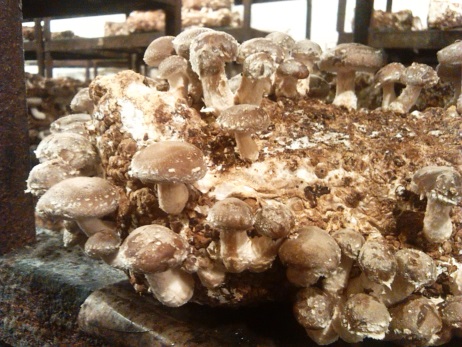Lentinula edodes (Berk.) Pegler/Shiitake



| ENG | The Romantic Mushroom/sawtooth oak mushroom |
| SK | húževnatec jedlý |
| CZ | houževnatec jedlý |
| PL | twardziak jadalny |
| HU | ehető shiitake |
Taxonomic characteristic
Realm: Fungi, Class: Agaricomycetes, Genus: Lentinula
Using
Within worldwide production is Shitake the second bestsellers fungus after mushrooms. Her fruiting bodies contain proteins, vitamins and minerals. Series of therapeutic effects is conditioned mainly from the used production strains and processes mushrooms fruiting bodies, which contain 85-95% water and 9 essential amino acids, particularly leucine, and lysine. Dry matter content 43-78% of carbohydrate. Minerals are represented mainly by calcium, phosphorus, iron, potassium and sodium. Of the vitamins B group that are thiamine, riboflavin, niacin and pantothenic acid. The active substance isolated from fruiting bodies eritadenine (a purine alkaloid) has shown in research antiviral activity and reducing blood cholesterol levels. As the most effective active ingredient in edible mushroom Lentinula edodes could be considered lentinan. This mushroom is perfectly applicable in gastronomy.
Botanical charakteristic
Hat size ranges on average 5 – 12 cm. Overall colour of fruiting bodies is light brown to dark brown with reddish-brown tinge and darker centre, the skin is usually scaly, whitish petals later light pink with brown spots. Stem of the fruiting body is 3-5 cm long and 1.5 cm rough, with scaly surface. The flesh is firm, white mushroom with a pleasant taste.
Why to have the plant in your garden:
The first reports about the cultivation of shiitake come from China in period of Dynasty Sung (960 – 1127). Originally it was a simple growing on the trunks of leafy trees with smaller properties, where into the bark fruiting bodies of mature fungi was smoothed, assuming that the spores will be captured in the crust and then they will germinate and spawn in a humid and warm climate and grow into the wood. The most commonly production of shiitake today is on bulk substrates made from sawdust of leafy wood enriched bran or cereal scrap (Antonín, Jablonský, 2012). Growers will be pleased by beautiful harvest and great use in the home kitchen.
Text:
Ing. Dávid Chmelár, Ing. Marcel Golian, SUA, Nitra, Slovak Republic
Photo:
Ing. Dávid Chmelár, Ing. Marcel Golian, SUA, Nitra, Slovak Republic
English Translation:
Ing. Ján Farkaš, SUA, Nitra, Slovak Republic
Links to scientific articles
Jablonský, I., Šašek, V. 2006. Jedlé a léčivé houby. Brazda Praha. 263. ISBN 80-209-0341-0.
http://link.springer.com/article/10.1007/s00253-002-1109-2
http://www.sciencedirect.com/science/article/pii/S0168165699002242

